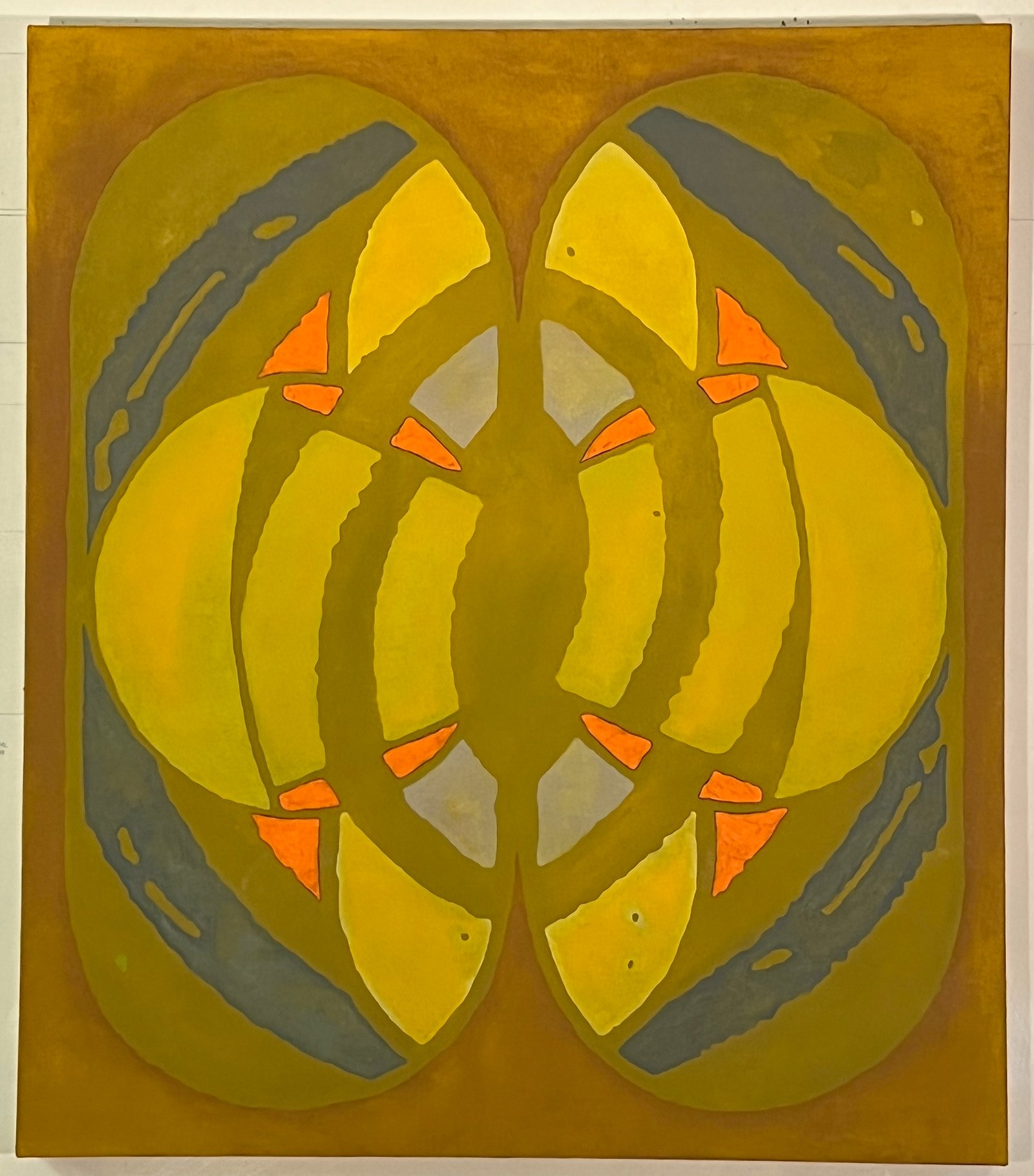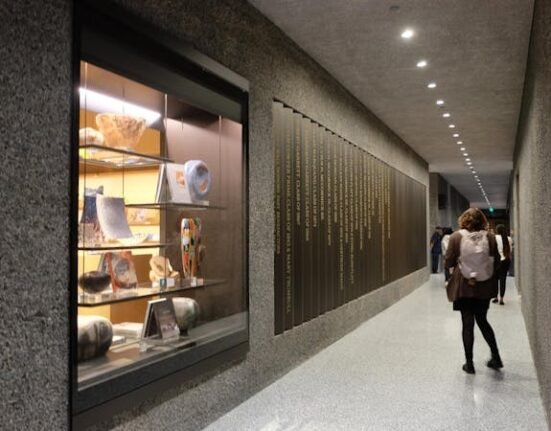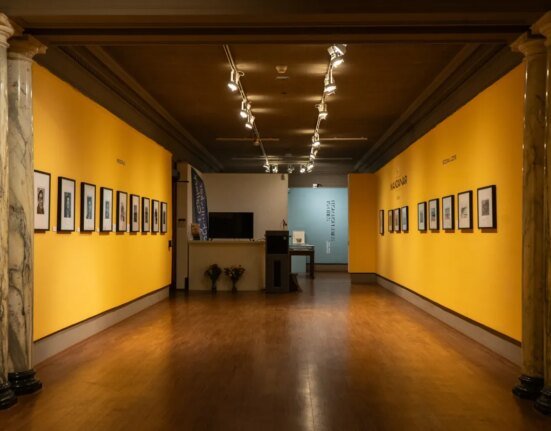SAUGERTIES, New York — In 1993, I reviewed Synthesis, an exhibition of 15 abstract artists at the now-defunct John Good Gallery. In my review, I called attention to two artists who I thought stood out; one was David Baker, whose painting “Avatars of the Tortoise” (1990) caught my eye. In 1996, a prominent New York Times art critic categorically dismissed the work in Baker’s third solo exhibition at Postmasters Gallery. Shortly afterward, Baker, who had parted ways with his gallery, and his wife, Joanne, left their rented loft in Jersey City and bought a schoolhouse in Saugerties, where they have lived ever since.
Since leaving New York City for the relative isolation of the Hudson Valley, Baker has explored the concentric circle motif in collage and painting. While he has not exhibited his paintings since moving to Saugerties, his film Shadow, Seed, Spagyric was shown at the New York Film Festival in 2011. All of this I learned after he introduced himself to me during the intermission of a poetry reading I gave, along with artist and poet No Land, at the Woodstock Shivastan Poetry Ashram Bookshop in Woodstock, New York. By the end of our conversation, we had professed our admiration for the ceramics of George Ohr, the self-proclaimed “Mad Potter of Biloxi,” and the poetry of Clark Coolidge and Robert Creeley, and planned a studio visit.

When I got to David’s studio, he began our visit by showing me a black three-ring binder of xeroxed pages, each in a protective sleeve. The first xerox showed a concentric circle, which he explained was the basis of the paintings I was about to see. He used the xerox copy as a drawing, which he cut up and reconfigured, using parts of other copies of the same image. Baker’s concentric circle initially alluded to Marcel Duchamp’s “Rotary Demisphere (Precision Optics)” (1925) and Jasper Johns’s “Target” paintings. However, when I looked at the paintings, I did not see a direct connection to these two artists. Instead, I remembered a note that Johns wrote to himself in a 1964 sketchbook: “Take an object / Do something to it / Do something else to it. [Repeat.]”
With some research, I learned that Baker first gained attention in the late 1980s for paintings that appropriated from a wide range of incongruous images, such as roots, targets, anatomy, and chipmunk heads. Even then he used xeroxes to cohere the composition. He made his breakthrough around the time he lost gallery representation, continuing to work in this way, but reducing his source to the concentric circle. He took appropriation art, which had by then devolved into commonplace acts of citation, quotation, and parody, and set it in a new direction.

While explaining his process to me, he told me that he had studied Indigenous Rock Art in remote canyons of the Southwest United States, as well as the architecture of Andrea Palladio in the Veneto of Italy, and outsider art in Lausanne, Switzerland, which houses the Collection de l’Art Brut. He added that Carl Schuster and Edmund Carpenter’s multivolume study Patterns That Connect (1996) was “an abiding touchstone” for his work.
My attention was first held by the palette of “Avatars of the Tortoise” (which I learned was a collective title of at least seven paintings done in the mid 1990s). Looking at his paintings prompted me to ask him about his palette and his predilection for muted, closely valued colors. Baker told me that these were guided by his color blindness to certain shades of red and green. Whatever Baker’s reason for the colors he uses in his paintings, it further set his work apart from other contemporary artists.
In “She Knew No Other Way” (2023), Baker renders three overlapping pinched forms, outlining them in thick gray paint. Muted blues and blue-greens fill many of the shapes created by the forms’ overlapping outlines, while a different blue mixed with gray in one large interior section offsets the sense of visual symmetry. For “Undulate (Vesica Piscis)” (2021), a ragged cerulean blue line composes a figure eight containing overlapping concentric circles. The resulting interior shape in each circle is known as vesica piscis (“bladder of a fish”). Four semicircles rising from the outer edges of the overall form invite us to read them as ears, while an undulating cerulean blue line snakes down the form’s center vertically. The entire image is set against a cool gray ground. While the configuration is derived from a xerox, everything feels hand painted, with particular attention paid to tone.

“The Ninth of Ninth” (2024) focuses on the conjoining and separation of forms. Two vertical oblong forms abut each other, creating a taut sense of visual tension between symmetry and asymmetry. The shapes are both permanently joined and forever distinct. A circle at the center of each form contains further circular lines, while a larger circle behind these divides the wholes into multiple parts.
Using orange-red, dirty, brownish pink, umber, black, brown, and dirty white to define each area in “The Ninth of Ninth,” Baker’s palette is both tonal and graphic. The curving bands are like expanding ripples, while the wide black line holds everything in check. Although Baker’s paintings call forth associations with the underbelly of tortoises, optical devices, a slice of a geode, and much else, he always holds these references at bay. The paintings are not about nature or art in itself, but about actively seeing, as the mind discovers connections and disconnections in his recombinant vocabulary of lines and shapes. They are about the pleasures of thinking and seeing and discovering connection, basic human activities that are integral to curiosity. Together, these paintings constitute a major achievement that remains almost completely unknown. Baker has made an oeuvre the art world urgently needs.








